Cochin International Airport
Cochin International Airport, Cochin (IATA: COK, ICAO: VOCI) is an international airport serving the city of Kochi, in the state of Kerala, India. Located at Nedumbassery, about 25 kilometres (16 mi) northeast of the city, Cochin International Airport is the first airport in India developed under a public-private partnership (PPP) model. This project was funded by nearly 10,000 non-resident Indians from 30 countries.[4]
Cochin International Airport | |||||||||||
|---|---|---|---|---|---|---|---|---|---|---|---|
 | |||||||||||
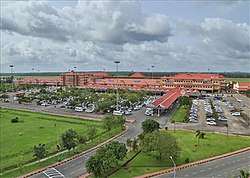 | |||||||||||
| |||||||||||
| Summary | |||||||||||
| Airport type | Public | ||||||||||
| Owner/Operator | Cochin International Airport Limited | ||||||||||
| Serves | Kochi Metropolitan Area
Thrissur Idukki Alappuzha Kottayam | ||||||||||
| Location | Nedumbassery, Kerala, India | ||||||||||
| Opened | 10 June 1999 | ||||||||||
| Hub for |
| ||||||||||
| Focus city for | |||||||||||
| Elevation AMSL | 9 m / 30 ft | ||||||||||
| Coordinates | 10°09′19″N 76°23′28″E | ||||||||||
| Website | cial | ||||||||||
| Map | |||||||||||
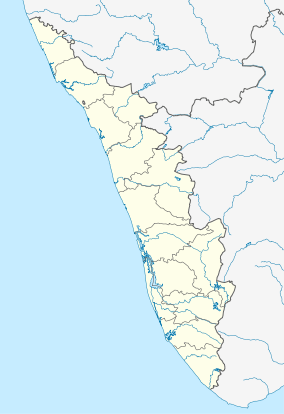 COK Location in the state of Kerala  COK COK (India) | |||||||||||
| Runways | |||||||||||
| |||||||||||
| Helipads | |||||||||||
| |||||||||||
| Statistics (April 2018 - March 2019) | |||||||||||
| |||||||||||
It is the busiest and largest airport in the state of Kerala.[5] As of 2019, the Cochin International Airport caters to 61.8% of the total air passenger movement in Kerala.[6] It is also the fourth busiest airport in India in terms of international traffic[7] and eighth busiest overall. In fiscal year 2018-19, the airport handled more than 10.2 million passengers with a total of 71,871 aircraft movements.[6] The airport is a primary base for Air India Express operations which is also headquartered in the city.
The airport operates three passenger terminals and one cargo terminal. With over 150,000 square metres (1,614,587 sq ft) in area,[8] the airport's Terminal 3 is one of the largest terminals in India. Cochin International Airport became the world's first fully solar powered airport with the inauguration of a dedicated solar plant.[9][10] For this entrepreneurial vision, the airport won the coveted Champion of the Earth award in 2018, the highest environmental honour instituted by the United Nations.[11]
History
The airport began as an airstrip on Willingdon Island, built in 1936 by the British Residency of Kingdom of Kochi, intended for transporting British officials involved in the development of the Cochin Port. The airstrip was converted into a military airport by the Indian Navy during World War II. The Royal Navy chose it as a strategic site for their headquarters in Southern India and as an air station cum landing craft and seaplane base.[12] The military facility hosted naval fighter planes and was intended to thwart possible Japanese air raids.[13] A small naval unit set up operations just two days before the outbreak of World War II.[14]
After Indian Independence, the Indian Navy operated the airport, though it permitted civilian aircraft to use the facility. The Gulf economic boom of the 1980s made it necessary to develop international connections to Kochi in the interests of expatriates working in the Middle East.[15]
Construction
The original proposal for the airport outlined an estimated cost of ₹1 billion (US$14 million) and an expected date of commission in 1997. Approval was granted in May 1993. The funding was envisaged to be from interest-free loans from non-resident Indians working abroad, donations from industrial undertakings, exporters, cooperative societies and loans from the state government. A body called the Cochin International Airport Society, under the chairmanship of the chief minister of Kerala K. Karunakaran, was registered in July 1993 to execute the project. To better fund mobilisation, as well as administrative convenience, a public limited company under the name Cochin International Airport Ltd. (CIAL) was registered in March 1994 with an authorised capital of ₹900 million (US$13 million).[16]
A total of 491 ha (1,213 acres) of land was acquired for the construction of the airport.[17] Approximately 2,300 landowners and 872 families were resettled under a rehabilitation package.[18] Major electric lines and an irrigation canal had to be diverted.
The facility was formally inaugurated by the then President of India, KR Narayanan on 25 May 1999 and the first commercial service began on 10 June 1999. The operations from the old naval airport were moved to CIAL on 1 July 1999.[19]
Expansion
Phase 1
The airport had 18,580 m2 (200,000 sq ft) of floor space at its inauguration. CIAL envisioned four phases of expansion over 20 years, the third phase of which was completed in 2009. The original airport terminal was envisioned to handle just 100 passengers at a time. However, by 2001, the international passenger traffic were growing, making necessary to redevelop the terminal.
In 2002, the floor area for the international operations of the original building rose due to the completion of a separate domestic terminal, shifting all domestic operations there.
Phase 2
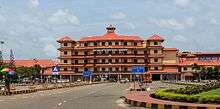
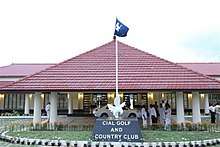

With a rising number of airlines operating at the airport, CIAL decided to construct an exclusive terminal for domestic operations, namely Terminal 2, making the international one Terminal 1, increasing the floor space for international operations by 37,161 m2 (400,000 sq ft). As part of phase two of the expansion plans, an airline center complex of 7,500 m2 (81,000 sq ft) was constructed on the western side of the terminal to accommodate airline and CIAL's administrative offices. The cargo terminal was also expanded in the second phase.
Phase 3
Work on the third phase was intended to accommodate 5 million passenger movements annually and was started in 2007.[20] The third phase involved the commissioning of a central block, connecting the domestic and international terminals and enlarging the airside area to accommodate more gates and waiting areas along with increased shopping areas. This increased the built-up area by another 29,700 m2 (320,000 sq ft).[21] The airside area of the international arrivals and departures blocks were integrated and glass walls were installed to allow for more natural light. The runway was re-surfaced in 2008.[22] The number of parking areas were increased from 15 to 24, including three dedicated for cargo airlines. The third phase also completed the expansion of the cargo village and a second aircraft taxi-way to the MRO facility.[23][24]
Phase 4
The fourth phase of expansion was originally planned to upgrade the domestic terminal, which has remained untouched in the past three phases.[25][26] However, the expansion plans were changed after the new UDF government took over the administration of the state in May 2011.
As per the revised plans, the international terminal is to face a major renovation before being converted completely into a domestic terminal, while a new state-of-the-art international terminal is coming up. As per the new plans announced by the board of directors in September 2011, the new international terminal would come up on the eastern side of the existing structure. The built-up space of the new terminal would be 140,000 m2 (1,500,000 sq ft) having segregated departures and arrivals at different levels.[27][28][29][30] The new terminal with an elevation featuring Kerala temple architecture will have all the latest features of international standards. Construction major Larsen & Toubro is building the facility which will be ready within 30 months. The two-level terminal will have provisions for 112 check-in counters, with in-line baggage screening facilities, 100 immigration counters, 3,716 square metres (40,000 sq ft) of duty-free shops at departure and arrival lounges, 19 boarding gates, 15 aerobridges, six baggage conveyor belts and fully covered alighting and boarding area.[31]
The current domestic terminal would be converted into "Executive Pavilion" and would handle VIP and private chartered flights and jets. The current international terminal, once converted into a domestic terminal, will have 5 aerobridges and 10 boarding gates facility, apart from increased parking bays.
Management
Cochin airport is the first in India to be built in a public–private partnership and is owned by a public limited company called Cochin International Airport Limited, better known as CIAL, floated by the Government of Kerala in 1994. The Government of Kerala holds 33.36% stake, making it the single largest investor in the project.[32] Indian government companies like Air India, BPCL, AAI hold 8.74% stake, while foreign companies like Abu Dhabi based Emke Group, the Oman-based Galfar Group, UAE based Majeed Bukatara Trading holds 5.42% stake. Indian companies hold 8.57% stake, while scheduled commercial banks like Federal Bank, SBT and Canara Bank holds 5.91%.[33] The remaining 38.03% stake is held by more than 10,000 personal investors from 29 countries, mostly non-resident Indians.[34]
The company has decided to go for public offering and giving 10 million shares to HUDCO as part of debt settlement, which would to lead HUDCO having 3.37% stake in the company and reduction of stake of other holders.[33]
The Chief Minister of Kerala is the ex-officio chairman of CIAL. V. J. Kurian is the managing director, appointed on 10 June 2011.[35]
Terminals
Cochin International Airport has three main terminals: two domestic and one international. There is also a cargo terminal.


.jpg)


Terminal 1 (Domestic)
Terminal 1 used to be an international terminal until the operations were shifted to the new international Terminal 3. The terminal underwent a massive upgrade and renovation after that, which took its total handling capacity to 4,000 passengers per hour which is 5 times the previous capacity. The renovated Terminal 1 was opened to travellers on 12 December 2018.[36]
With a total built-up area of 55,742 m2 (600,000 sq ft),[36] the Terminal 1 has 56 check-in counters, 7 aerobridges and conveyor belt system to transfer baggage from 12 flights at a time. It is also equipped with 6 reserve lounges, art area, a food court, executive lounge, and a 4,645-square-metre (50,000 sq ft) shopping area.[36] The terminal has a solar carport facility that can generate 2.4 MW of power and can house 1,400 cars. Together with the solar carport at the international Terminal 3, it can generate 5.1 MW of power which is the largest in a carport in the world.[37]
Terminal 2 (Executive)
Terminal 2 has an area of 10,000 m2 (110,000 sq ft) and is designed to handle up to 400 passengers at peak times. The departure hall has 26 common use terminal equipment (CUTE) enabled check-in counters, including 6 premium check-in counters, 4 self check in counters. It has 6 security gates and a common waiting area that can accommodate 400 passengers at a time. There is also a family lounge and a premium lounge for business class passengers and a food court is housed in the waiting area, while a restaurant operates in entry lobby. There are 4 remote gates facility available for domestic passengers. The arrivals hall has 2 baggage carousels.[38] This block was converted into an executive terminal on 12 December 2018.
Terminal 3 (International)
The new International Terminal 3 was opened to travellers on March 2017. The theme of the terminal is inspired from Thrissur Pooram and is built in traditional Kerala architecture. 15 real size fibre elephants, adorning traditional costumes welcome the travellers at the departure facility area. The terminal has 5 entry gates, 84 check-in counters and 80 immigration/emigration counters. It is equipped with 10 escalators, 21 elevators, and 3 moving walkways.[39] The terminal has a solar carport facility with capacity of generating 2.7 MW power and can provide parking facility to 1,400 cars. Along with the solar carport at the domestic terminal T1, it is the largest solar carport in the world with a total capacity of 5.1 MW of power and parking facility to 2,800 cars.[37]
With a total area of more than 150,000 m2 (1,614,587 sq ft), the terminal is built over 4 levels. The ground level handles arrivals. With a total ground area of around 41,156 m2 (442,999 sq ft), it has 10 customs counters, 3 bank counters, shopping complex for passengers and general public, VIP lounge, arrival duty-free shops and baggage claim area.[39] The second level (5.5 metres above ground level) also handles arrivals and is equipped with 30 immigration counters, 10 e-T-Visa counters, 5 health check counters, and 2 moving walkways.[39] The third level (10.5 metres above ground level) is the departure facility area. It has a 20,836 m2 (224,277 sq ft) check-in area, 3 check-in islands having total of 84 counters, 40 emigration counters, an 800-square-metre (8,611 sq ft) departure duty-free shop, 3 VIP reserved lounges, airline offices, 2 prayer rooms, and 1 moving walkway. The fourth level (15.5 metres above ground level) is the departure security hold area. With an area of more than 8,674 m2 (93,366 sq ft), it has a food court, restaurant, 3 airline executive lounges, smoking lounge, bar and reclining area.[39]
With the commissioning of Terminal 3, Cochin International Airport became India's 4th largest airport after Delhi, Mumbai, and Kolkata, with a total built up area of more than 213,677 m2 (2,300,000 sq ft) for commercial operations.
Cargo
Cochin Airport has a dedicated cargo centre on the eastern side of the complex. The cargo centre is one of the largest facilities in India with a total floor space of 11,000 m2 (120,000 sq ft) in 20 hectares (50 acres) of land. There are three complexes in the cargo village:
- The Centre for Dry Cargo (CDC), with an area of 4,600 m2 (50,000 sq ft), has a dedicated warehousing facility and air-customs inspection facility for both import and export.[40]
- The Centre for Perishable Cargo (CPC) is the largest dedicated cold storage centre for perishable goods in India. It has a floor area of about 2,000 m2 (22,000 sq ft) and can handle approximately 25,000 tonnes of cargo. It was commissioned in 2008 at a cost of ₹380 million (US$5.3 million) jointly by CIAL, Government of India through Agricultural and Food Promotion Export Development Authority (APEDA), and Government of Kerala.[41]
- The Transshipment Cargo Complex is a dedicated warehouse allocated for transshipment cargo. The import and export cargo from the customs warehouses in the catchment area, as well as from airports like Chennai, Bangalore, Coimbatore, etc., are handled and stored at this centre for export.[40]
In addition, an exclusive domestic cargo complex has also been constructed for private domestic logistics firms and India Post services.
Infrastructure
Air traffic control
The air traffic control (ATC) tower is 60 m (200 ft) tall. Cochin ATC controls flights below an altitude of 7,800 m (25,500 ft). The airport has two instrument landing systems (ILS) using distance measuring equipment (DME) which enable flights to land from both sides of the runway even in rough weather conditions. CIAL is the only airport in the country besides the airport in metros to have such facility.[42] The ATC uses Doppler VHF omni range I and II.[43]
Large-scale upgrades such as the latest AIRCON 2100 air traffic control automation system were also introduced.[44]
Airport surveillance radar
The Airports Authority of India has installed an advanced airport surveillance radar (ASR) as well as monopulse secondary surveillance radar (MSSR).[45][46] In addition, a surface movement radar was installed for effective monitoring of flights on the runway and in parking bays.[47]
Runway
Cochin International Airport has one 3,400m long runway oriented as 27/09, which can handle Code E planes. It has a full-length parallel taxiway of 3,400 m (11,200 ft). The 807 m × 125 m (2,648 ft × 410 ft) apron comprising 16 stands can accommodate five wide bodied and eight narrow bodied aircraft.[48][49][50] The runway is spread over the panchayat areas of Nedumbasserry, Sreemoolanagaram and Kanjoor.
Cochin Airport has one helipad for dedicated use of helicopters, meant for air-taxi purposes. Plans for constructing a heliport is underway.[51]
Naval Air Enclave
.jpg)
The Indian Navy has set up a Naval Aircraft Enclave at Cochin International Airport Ltd. (CIAL). The Naval Aircraft Enclave comprises a hangar for bigger aircraft of the Navy, administrative office, disbursal centre, apron capable of holding 2 Boeing type aircraft (P-8I long-range maritime reconnaissance aircraft) and a taxi track. The Naval Aircraft Enclave at Cochin airport is the second such facility of the Navy attached to an international airport, after Mumbai. It is the first public-private participation model airport to hand over land to the Navy for such a facility.
Construction began in 2013 on 4 hectares (10 acres) of Navy-owned land at the airport.[52][53]
Indian Coast Guard Air Enclave
The Indian Coast Guard has taken space in CIAL to develop its second air squadron in Kochi after INS Garuda facility to improve coastal air surveillance and air related assistance.
The facility comprises 2 hangars to accommodate the Chetak helicopter squadron, and the Dornier squadron along with advanced light helicopters are expected to be based here. The Air Enclave would have a 50m taxi link to the runway at CIAL and would consist of aircraft hangars, technical areas and administrative buildings. which is towards last phase of construction.[54]
Airlines and destinations
Passenger
All flights are cancelled till 3rd May due to COVID-19.
| Airlines | Destinations |
|---|---|
| Air Arabia | Sharjah |
| AirAsia | Kuala Lumpur–International |
| AirAsia India | Bangalore, Delhi, Hyderabad, Mumbai, Visakhapatnam |
| Air India | Bangalore, Chennai, Delhi, Dubai–International, Jeddah, Mumbai, Riyadh, Thiruvananthapuram |
| Air India Express | Abu Dhabi, Bahrain, Dubai–International, Doha, Kozhikode, Muscat, Salalah, Sharjah, Thiruvananthapuram |
| Alliance Air | Agatti, Mysore |
| Emirates | Dubai–International |
| Etihad Airways | Abu Dhabi |
| flydubai | Dubai–International |
| GoAir | Ahmedabad, Bangalore, Delhi, Hyderabad, Jaipur, Mumbai |
| Gulf Air | Bahrain |
| IndiGo | Abu Dhabi, Ahmedabad, Bangalore, Chennai, Delhi, Doha, Dubai–International, Hubli, Hyderabad, Kannur, Kolkata, Kuwait, Malé, Mumbai, Muscat, Pune, Raipur, Thiruvananthapuram |
| Jazeera Airways | Kuwait |
| Kuwait Airways | Kuwait |
| Malaysia Airlines | Kuala Lumpur–International |
| Maldivian | Hanimaadhoo, Malé[55] |
| Malindo Air | Kuala Lumpur–International |
| Oman Air | Muscat |
| Qatar Airways | Doha |
| Saudia | Jeddah, Riyadh |
| SilkAir | Singapore |
| SpiceJet | Chennai, Delhi, Dubai–International, Mumbai, Port Blair, Pune |
| SriLankan Airlines | Colombo–Bandaranaike |
| Thai AirAsia | Bangkok–Don Mueang |
| Vistara | Delhi |
| Destinations map |
|---|
 Cochin Sharjah Kuala Lampur Visakhapatnam Jeddah Riyadh Thiruvananthapuram Bangkok Colombo Pune Singapore Doha Muscat Male Hanimaadhoo Port Blair Kuwait Ahmedabad Goa Hubballi Kannur Raipur Bahrain Jaipur Mysore Agatti Kozhikode Salalah Destinations from Cochin International Airport (Red) = Year-round Destination (Green) = Seasonal Destination (Blue) = Future Destination |
Security
Cochin International Airport is listed among the 12 major airports of India. Its safety and security is handled by the Bureau of Civil Aviation Security through the Central Industrial Security Force (CISF). Cochin was the third international airport and the first private airport in the country to come under the cover of CISF in 2001, after the Government of India decided to hand over airport security to CISF in the wake of the hijacking of Indian Airlines Flight 814. Security was handled by the Kerala Police; Special Branch of Kochi Police before the CISF. The airport company's Aviation Safety Wing (ASW) oversees security facilities and equipment. The ASW is also responsible for fire and emergency services.
Security management training is provided by CIAL's Aviation Academy and personnel are employed by the company as security agents – deployed in baggage screening rooms, entry gates, the general cargo area and the lounge areas. CIAL ASW employs Army-trained sniffer dogs to check for explosives in baggage areas, the only Indian airport to have such a facility.[56] CIAL has introduced three state-of-the-art ION scanning detectors that can identify small amounts of material, down to nanograms, of explosives.[57]
The airport is under the direct protection of the Kochi City Police, who have a station outside the terminal. CISF maintains two armed squadrons and one bomb detection and disposal squad.[58] CISF has a command centre 250 metres outside the terminal, with an intelligence division and mobilisation cell. The air customs division operates a narcotics detection squad in the terminal. The CIAL ASWs are working on installing a fully automated perimeter intrusion detection system that will detect any possible violation, using sensors that will provide critical time for the security forces to react. Phase one of the intrusion prevention system is in place with barricades, automatic retractable bollards, surveillance cameras, parking gate management systems and the introduction of biometric ID cards for staff.[59]
The immigration department is handled by Kerala Police, Special Branch officials trained by the Bureau of Immigration.[60]
The airport company also has a high-end robotic security system capable of remote-handling of explosive devices and fire-fighting and hostage situations . The system is operational from September 2014, making CIAL the first in South India to have such a facility. It comprises safety robots developed by Canada-based Pedsco Ltd. and Threat Containment Vessel (TCV) and sophisticated luggage containment vehicle – both developed by Nabco, USA. The main equipment of the system is a threat containment vessel (TCV) carried by robots, which is capable of containing a blast of minimum 8 kg of TNT or equivalent quantity of explosive, triggered by suspected luggage including chemicals, radioactive materials and bombs. The container is reusable as it withstands repeated detonations and size of the TCV can be adjusted with the size of the suspected baggage. In addition to TCV, the technology also comprises a remote mobile Investigator (RMI)-9WT, which is a multipurpose six-wheel vehicle with removable tracks for step climbing capability. Using fixed arm extenders, the robot can be configured for different applications such as under car searches and second-storey window access.[61]
Education and training
Since 2008, CIAL has been the first airport to venture into providing higher education in aviation management and technical areas to overcome the shortage of skilled manpower in the aviation industry.[62] CIASL has teamed up with the Indira Gandhi National Open University (IGNOU) to start two schools in aviation education.
CIAL Aviation Academy provides two-year management degrees in aviation and airport management, operations, economics, finance and human resources, along with short-term aviation oriented vocational diplomas. The academy also trains technical manpower required for airport operations. Air India Express has its temporary stewards grooming and training center in the facility.[63][64]
Aviation Security Training Institute — The Aviation Security Training Institute (ASTI), envisioned by the Bureau of Civil Aviation Security has been inaugurated in February 2014. The institute has state-of-the-art facilities like X-ray simulators (21), explosive model room, two classrooms with LCD projectors and other training infrastructures. Explosive model rooms display different types of switch mechanism to trigger explosion. Library consists of CDs, catering to International Civil Aviation With the establishment of ASTI in Kochi, employees and management personnel from Mangalore, Kozhikode, Coimbatore, Trichy, Madurai and Thiruvananthapuram airports can take training here. Employees of the proposed Kannur international airport are also likely to be trained here.[65]
Ground transportation
CIAL is located between National Highway 544 (NH 544), one of the main highways of South India and the Main Central Road (MC Road), one of the State Highways of Kerala. An expressway is planned from NH 49 to the MC Road to facilitate faster transport.[66] Though the main railway line is only about 500 metres from the airport, the nearest station is Angamaly about 8 km away.
- Air-taxi services
Cochin airport has dedicated air-taxi services for passengers to travel to major pilgrim destinations in Kerala as well as to cities like Trivandrum and in northern Kerala like Kozhikode. In association with Bharat Airways, it provides scheduled air-taxi services to Sabarimala.[67]
CIAL Aerotropolis
One of the future projects for the airport is the CIAL Aerotropolis, or Airport City, with a total area of 202 hectares (500 acres).[68][69] The Aerotropolis was proposed by its founder, V.J. Kurien, to ensure additional revenue sources for the growth of the company and to increase airport traffic through tourism and allied activities. The proposed Aerotropolis will be in Nedumbassery and nearby villages, aiming to convert into a self-sustainable town, with the airport forming the core element with a residential zone. Work on the Aerotropolis commenced in 2007.
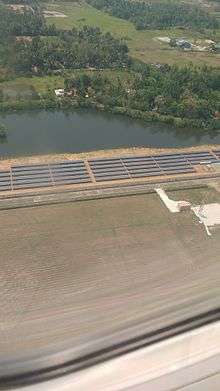
Manufacturing and business zone
The master plan envisages the creation of a Special Economic Zone (SEZ) for aircraft-allied industries, especially spare parts and OEM manufacturing units, an airline research and development center, workshops and service zones. In addition to this an Information Technology Park, with dedicated airline support technology, design and development centers is also proposed. An integrated logistics center and central container freight station are planned at the cargo village.[70]
CIAL's proposal for establishing the SEZ was approved by the Board of Approval of SEZs in 2008; however, work is yet to start due to the global recession. The project is estimated to begin by August 2011.
CIAL solar power project
CIAL Solar Power Project is a 15 megawatt (MW) photovoltaic power station built by CIAL. Cochin International Airport became the first fully solar-powered airport in the world with the commissioning of the plant.[71][72]
The plant comprises 46,150 solar panels laid across 18 ha (45 acres) near the international cargo complex. The plant has been installed by the Germany-based M/s Bosch Ltd. It is capable of generating 50,000 units of electricity daily, and is equipped with a supervisory control and data acquisition system (SCADA), through which remote monitoring is carried out. The project components include PV modules of 265Wp capacity manufactured by Renesola, and inverters of 1MW capacity manufactured by ABB India.[73]
The plant is coupled with a 1.1 MW solar plant that was commissioned in 2013, the first megawatt scale installation of Solar PV system in the state of Kerala. This plant was installed by Emvee Photovoltaic Power Pvt. Ltd., consisting of 4,000 monocrystalline modules of 250Wp and 33 string inverters of 30 kW capacity each.[74]
CIAL plans to double the solar production to 28.8 MW of power production within 2 years as part an ambitious plan to expand solar power with 3 major projects which are on construction stages. The first will come up over a 3.4 km-long (2.1 mi) canal near to the airport, the second is through development of India's first solar carport roof utility plan and the third will use ground level panels on open space near the airport.[75]
Incidents
- On 25 April 2010, Emirates Flight EK 530, a Boeing 777-200 from Dubai, dropped around 61 metres (200 ft) during heavy turbulence as the aircraft entered a thick cumulonimbus cloud while on its descent. 20 passengers were injured and some internal damage was caused to the plane. The aircraft was on descent into Kochi when the incident occurred. There were 350 passengers and 14 crew on board.[76]
- On 25 August 2011, a 13-year-old boy was found roaming around the runway area, raising questions about the security system of the airport.[77]
- On 29 August 2011, Gulf Air Flight GF 270, an Airbus 320 from Bahrain, carrying 137 passengers skidded off the runway at 3.55 am during its descent. The reason for the crash is suspected to be the heavy rain at the time. The aircraft had been said to have slipped off the runway and landed nose first. The aircraft broke one of its wings while landing and stalled air traffic for hours. Passengers after the crash, in chaos, were reported to have jumped from the aircraft through emergency exit doors even before stairways were brought into place. The crash caused seven minor injuries and two serious injuries due to the chaos that followed.[78]
- On 4 September 2017, Air India Express Flight IX 452, a Boeing 737-800 which arrived from Abu Dhabi, got stuck in the drain canal while taxiing to the international terminal-3 after landing. Passengers and crew were safely evacuated. The incident happened when the pilot took a wrong turn from the parallel taxiway, almost 90 meters before the link taxiway through which the aircraft was supposed to vacate.[79]
2018 Kerala floods
As a consequence of 2018 Kerala floods, the airport was closed 14–29 August 2018. Water in the Periyar, which flows 500 metres (1,640 ft) away from the airport, rose to 1,433 mm (4.7 ft) during these days.[80] The runway and other facilities were non-functional due to excessive flooding and inclement weather.[81] Flights to Kochi were diverted to and were operating from other airports in the state like Thiruvananthapuram and Kozhikode.[82][83][84] From 20 August 2018, INS Garuda (a naval airbase in Kochi) was used as a civilian airport for small aircraft operations to neighbouring cities like Bangalore, Chennai, and Coimbatore.[85][86][87] The airport reopened on 29 August 2018, 14:00 Indian Standard Time (UTC+05:30).[88] It suffered an estimated loss of ₹3 billion (US$42 million) during the closed period.[89][90][91]
2019 Kerala floods
As a consequence of 2019 Kerala floods, water logging in the runway due to the heavy rains lead to temporary suspension of airport operations from 8 August 2019 to 12:00 Indian Standard Time on 11 August 2019.[92]
Awards and accolades
Cochin International Airport has received numerous awards and accolades over the course of period. The airport achieved major international recognition in 2015 when it became the first fully solar-powered airport in the world. In 2017, it also became the first airport in the world to implement a solar carport, a parking bay with rooftop solar panels. The airport was selected as "the best non-metro airport in India" in 2016 by the Air Passengers Association of India.[93] The airport has also won numerous awards for energy conservation, productivity and infrastructure.[94] In July 2018, the airport was selected for the coveted Champion of the Earth award, the highest environmental honour instituted by the United Nations.[11]
See also
- Trivandrum International Airport
- Calicut International Airport
- Kannur International Airport
- Aranmula International Airport
- Sabarigiri International Airport
- Quilon Aerodrome
- Agatti Airport
- Airports in India
- List of busiest airports in India by passenger traffic
References
- "Traffic News for the month of March 2019: Annexure-III" (PDF). Airports Authority of India. 1 May 2019. p. 3. Retrieved 1 May 2019.
- "Traffic News for the month of March 2019: Annexure-II" (PDF). Airports Authority of India. 1 May 2019. p. 3. Archived from the original (PDF) on 1 May 2018. Retrieved 1 May 2019.
- "Traffic News for the month of March 2018: Annexure-IV" (PDF). Airports Authority of India. 1 May 2018. p. 3. Archived from the original (PDF) on 1 May 2018. Retrieved 1 May 2018.
- "Kochi airport is the first aviation venture owned by the public". rediff.com. 6 December 1999. Archived from the original on 20 January 2008. Retrieved 11 November 2007.
- "Airports in Kerala-Helpful guide for tourists visiting Kerala". 8 November 2019.
- "Crore plus transit CIAL in 2018-19; domestic travellers exceed international". The New Indian Express. 8 April 2019.
- "Cochin International Airport's new terminal to open in March". Deccan Chronicle. 28 January 2017.
- "Cochin International Airport new T3: From solar power to world-class facilities, this Kerala airport is special". Financial Express. 18 July 2017. Retrieved 9 December 2018.
- "Cochin International Airport set to become worlds's first fully solar-powered major airport". LiveMint. Kochi, India. 18 August 2015.
- Menon, Supriya (9 October 2015). "How is the world's first solar powered airport faring? - BBC News". BBC News. Bbc.com. Retrieved 1 December 2016.
- "CIAL chosen for UN environmental honour". The New Indian Express. 26 July 2018.
- Archived 7 February 2012 at the Wayback Machine
- The origin of INS Venduruthy can be traced to 31 August 1939, when a small naval contingent was positioned in Kochi under Royal Indian Navy Captain L. Wadeson, who assumed the duties of Naval Officer-in-Charge, Cochin. http://www.hindu.com/2010/07/02/stories/2010070250590200.htm
- "Kerala / Kochi News : INS Venduruthy celebrates anniversary". The Hindu. Chennai, India. 24 June 2006. Retrieved 8 January 2014.
- "The Official Website of Cochin International Airport". Cial.aero. 30 March 1994. Retrieved 5 May 2014.
- "CIAL – A NOVEL VENTURE IN INDIAN CIVIL AVIATION". Government of India, Press Information Bureau. Retrieved 12 January 2011.
- "CIAL: Corporate Project Details". CIAL. Retrieved 28 September 2015.
- "GOVERNANCE ISSUES IN AIRPORT DEVELOPMENT: LEARNINGS FROM COCHIN INTERNATIONAL AIRPORT LTD" (PDF). IIM Ahmedabad. Archived from the original (PDF) on 14 June 2011. Retrieved 12 January 2011.
- "A Brief History". CIAL. Archived from the original on 15 December 2010. Retrieved 12 January 2011.
- Travel & Tourism Newsletter, hotels, airlines, destination – January 2007 Archived 31 March 2010 at the Wayback Machine "Phase 3 expansion". 14 December 2010. Archived from the original on 14 December 2010.
- "New international departure terminal to be opened soon". The Hindu. Chennai, India. 22 October 2008. Archived from the original on 8 November 2012. Retrieved 6 November 2010.
- "Flights to Kochi airport to be rescheduled". The Hindu. Chennai, India. 18 March 2008. Archived from the original on 28 October 2008. Retrieved 27 October 2010.
- "Capabilities". Cochin International Aviation Services. Retrieved 26 October 2017.
- "About CIAL Overview". Cochin International Airport. Retrieved 26 October 2017.
- "Rs.100 crore for airport expansion". The Hindu. Chennai, India. 30 January 2009. Archived from the original on 8 November 2012. Retrieved 27 October 2010.
- "Airports Economic Regulatory Authority (AERA) - Airport Details". AERA. Retrieved 10 February 2012.
- "State-of-the-art terminal at CIAL soon — Kochi — The Hindu". thehindu. Chennai, India. 16 December 2012. Retrieved 22 February 2013.
- "CIAL to have new International terminal — Kochi — The Hindu". business-standard.com. Retrieved 22 February 2013.
- "New terminal at CIAL soon — Kochi — The Hindu Business Line". thehindubusinessline.com. Retrieved 22 February 2013.
- "CM: New international terminal for Kochi airport — National — news — Business Standard". Ibnlive.in.com. Retrieved 10 February 2012.
- "CIAL". Cial.aero. 1 February 2014. Retrieved 5 May 2014.
- "Finance Accounts 2008–09, Govt of Kerala" (PDF). Comptroller and Auditor General of India. Archived from the original (PDF) on 21 July 2011. Retrieved 14 January 2011.
- "Cochin airport to go for initial public offering". Deccan Chronicle. Archived from the original on 9 February 2016. Retrieved 5 May 2014.
- "Investor Info". CIAL. Archived from the original on 15 December 2010. Retrieved 14 January 2011.
- "Welcome to Cochin International Airport...The travel friendly airport!". CIAL Ltd. Retrieved 6 July 2011.
- "Ethnic charm awaits travellers at Cochin International Airport". The New Indian Express. 16 December 2018. Retrieved 9 December 2018.
- "World's largest carport in Kochi". Deccan Chronicle. 9 February 2018. Retrieved 9 December 2018.
- "The Official Website of Cochin International Airport". Cial.aero. Retrieved 8 January 2014.
- "Cochin International Airport - Terminal 3" (PDF). CIAL. Retrieved 9 December 2018.
- "Cargo facilities at Cochin Airport". Archived from the original on 1 July 2009. Retrieved 20 December 2019.
- "Cochin Airport to have largest perishable cargo centre in India". Freshplaza.com. Retrieved 5 May 2014.
- "Cochin International Airport Ltd installs second Instrument Landing System". Deccan Chronicle. 11 May 2018.
- "The Official Website of Cochin International Airport". Cial.aero. Retrieved 10 February 2012.
- "New radar to be commissioned at Kochi airport Friday". IBN Live. Press Trust of India. 12 September 2013. Retrieved 31 August 2014.
- "Airports Authority of India". Aai.aero. 30 January 2012. Archived from the original on 24 June 2014. Retrieved 10 February 2012.
- "New radar for Kochi airport in 6 months". The Times of India. 3 September 2011.
- "CIAL to install radar at airport". The Hindu. Chennai, India. 29 September 2011.
- "The Official Website of Cochin International Airport". Cial.aero. Retrieved 10 February 2012.
- "Kochi Airport (COK) Details — India". World-airport-codes.com. Archived from the original on 17 February 2012. Retrieved 10 February 2012.
- "Kochi (COK) - Airport details". Theairdb.com. Retrieved 10 February 2012.
- Heli taxi service launched at Kochi airport The New Indian Express "Helipad at Kochi airport". 14 December 2010. Archived from the original on 14 December 2010.
- "Aircraft enclave for Navy at Cial". Times of India. 11 April 2013.
- Our Bureau (10 April 2013). "CIAL to have Naval Aircraft Enclave | Business Line". Thehindubusinessline.com. Retrieved 8 January 2014.
- chacko Joseph (9 January 2010). "Brute Gorilla: Foundation Stone Laying of Indian Coast Guard Air Enclave, Kochi". Brutegorilla.blogspot.in. Retrieved 1 December 2016.
- "Maldivian to start operations from Kochi". The Hindu. 18 September 2019.
- Passenger Terminal Today Archived 15 July 2011 at the Wayback Machine "Sniffer dogs at airport". 14 December 2010. Archived from the original on 14 December 2010.
- CIAL introduces The New Indian Express "ION scanning detectors". 14 December 2010. Archived from the original on 14 December 2010.
- KERALA. "BDDS to enhance security at Cochin airport - KERALA". The Hindu. Retrieved 1 December 2016.
- "Enhanced security equipment at Cochin airport". The Hindu. Chennai, India. 19 January 2010. Archived from the original on 13 October 2010. Retrieved 29 October 2010.
- Radhakrishnan, S. Anil (15 June 2010). "Airport facing lack of immigration officials". The Hindu. Chennai, India. Archived from the original on 7 January 2016. Retrieved 26 June 2013.
- "Robotic security for Kochi airport". The Hindu. 25 August 2014. Retrieved 1 December 2016.
- "CIAL academy". The Times of India. 9 March 2009. Archived from the original on 23 July 2018. Retrieved 18 October 2010.
- "Aviation academy: CIAL ties up with IGNOU". The Hindu. Chennai, India. 11 March 2009. Archived from the original on 8 November 2012. Retrieved 18 October 2010.
- Cochin International Aviation Services Ltd Archived 23 October 2010 at the Wayback Machine "Cochin International Aviation Services Ltd". 14 December 2010. Archived from the original on 14 December 2010.
- Mampilli, Joseph (23 January 2014). "Aviation Security Training Institute to be Ready Soon". The New Indian Express. Retrieved 5 May 2014.
- "Expressway to the airport". Archived from the original on 14 December 2010. Retrieved 20 December 2019.
- Helicopter service launched for pilgrims in Kochi "Helicopter service launched for pilgrims in Kochi". 14 December 2010. Archived from the original on 14 December 2010.
- CIAL Aertropolis
- "Archived copy". Archived from the original on 6 January 2012. Retrieved 25 December 2011.CS1 maint: archived copy as title (link) CIAL.AERO
- Kochi Aerotropolis Archived 12 August 2010 at the Wayback Machine "Kochi Aerotropolis". 14 December 2010. Archived from the original on 14 December 2010.
- "How is the world's first solar powered airport faring?". BBC news. 9 October 2015. Retrieved 24 April 2017.
- Crew, Bec (20 August 2015). "India Establishes World's First 100 Percent Solar-Powered Airport". report. scienceAlert. Retrieved 24 April 2017.
- "Kochi airport installs 12MW solar plant". The Hindu business line. Retrieved 13 April 2016.
- "CIAL all set to become the first solar powered airport in the country". Retrieved 13 August 2016.
- Times News Network (6 July 2016). "Cial places three more solar bets - Times of India". Times of India. Retrieved 24 April 2017.
- 'Emirates pilot couldn't avoid Cumulonimbus cloud'- TIMESNOW.tv – Latest Breaking News, Big News Stories, News Videos Archived 28 April 2010 at the Wayback Machine "Emirates pilot couldn't avoid Cumulonimbus cloud". 14 December 2010. Archived from the original on 14 December 2010.
- "Boy trespasses into Kochi Airport — southindia — Kochi — ibnlive". Ibnlive.in.com. Retrieved 5 May 2014.
- Gulf Air skids off runway at Kochi Airport NDTV, 29 August 2011
- "Air India Express aircraft veers off taxiway at Kochi airport, all passengers safe". The Indian Express. 7 November 2017. Retrieved 19 November 2017.
- "After being shut for 15 days due to floods, Kochi airport finally reopens". The News Minute. 30 August 2018. Retrieved 31 August 2018.
- "Kerala floods: Kochi airport to remain closed till August 26 afternoon - Times of India". The Times of India. Retrieved 31 August 2018.
- "Kochi Airport Shut Till Saturday, Flights Diverted to Calicut and Thiruvananthapuram". News18. Retrieved 31 August 2018.
- "Reschedule Kochi flights to Trivandrum and Calicut, Centre tells airlines - Times of India". The Times of India. Retrieved 31 August 2018.
- "Kerala floods: GoAir, IndiGo to operate special flights to and from Trivandrum airport - Times of India". The Times of India. Retrieved 31 August 2018.
- Chowdhury, Anirban; Krishnakumar, P. K. (21 August 2018). "Naval air base at Kochi opened up for commercial flights". The Economic Times. Retrieved 31 August 2018.
- "Alliance Air to fly ATR to Kochi naval airbase from Monday, other airlines may follow suit - Times of India". The Times of India. Retrieved 31 August 2018.
- "Alliance Air To Operate Flights From Kochi Naval Base For Rescue Ops". NDTV.com. Retrieved 31 August 2018.
- "Kochi airport reopens after 15 days of closure". The Hindu. Special Correspondent. 30 August 2018. ISSN 0971-751X. Retrieved 31 August 2018.CS1 maint: others (link)
- "Kerala floods: Kochi airport suffers estimated loss of over Rs 220 crore". The Economic Times. 21 August 2018. Retrieved 31 August 2018.
- "How Kochi airport reopened in 14 days after floods caused Rs 300 cr-worth loss". The News Minute. 5 September 2018. Retrieved 22 September 2018.
- "CIAL seeks Dutch help to tackle flood at the airport". Deccan Chronicle. 5 September 2018. Retrieved 22 September 2018.
- "Kerala rain live updates: Cochin airport resumes operations; Army reaches landslide-hit Nilambur". OnManorama. Retrieved 20 December 2019.
- "National award for Cochin international airport". Deccan Chronicle. 30 August 2016.
- "About CIAL". Cochin International Airport. Retrieved 7 June 2017.
External links
![]()
- Cochin International Airport at Airports Authority of India web site
- Cochin Airport Official Website
- Airport information for VOCI at World Aero Data. Data current as of October 2006.
- Accident history for COK at Aviation Safety Network